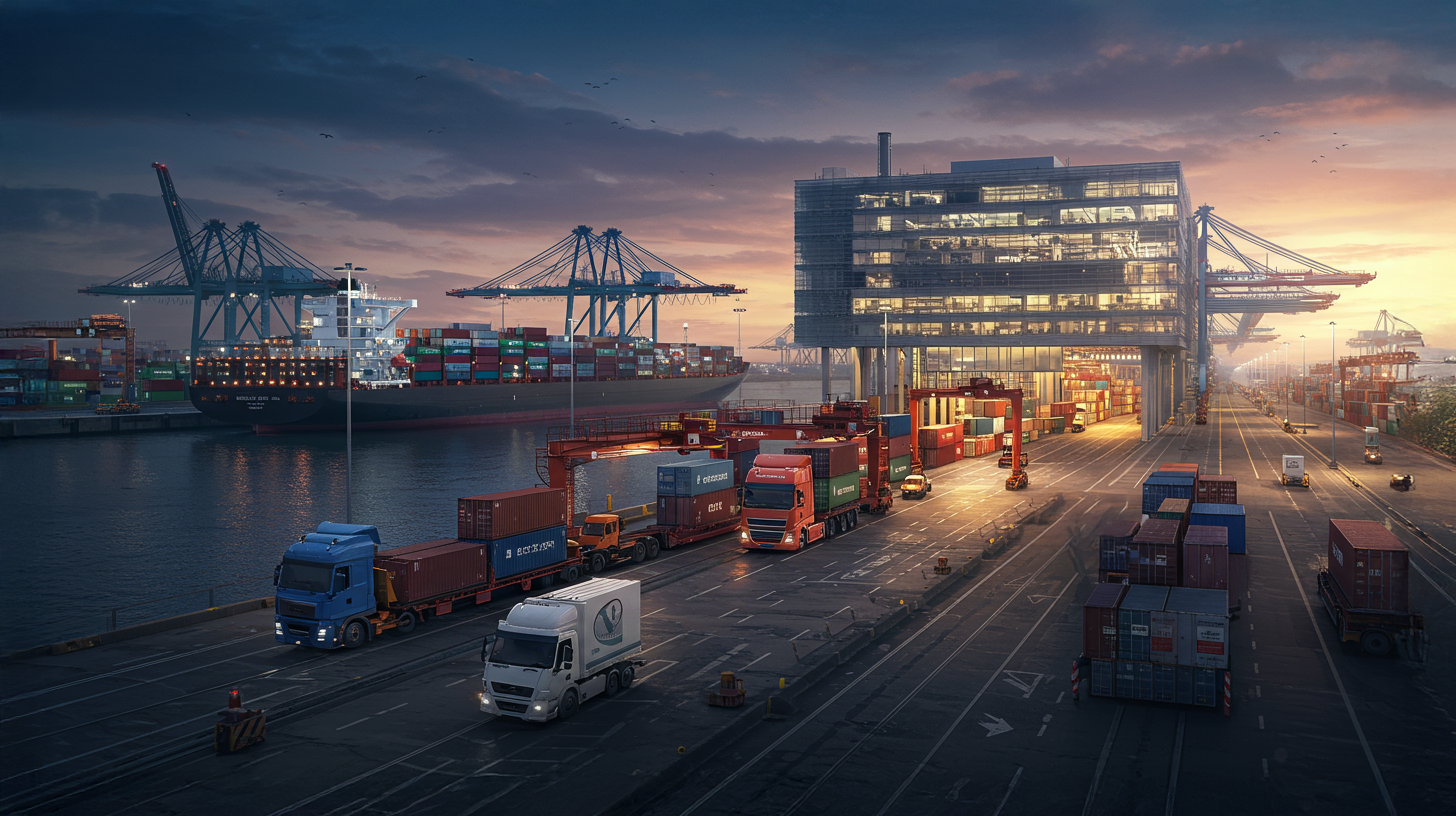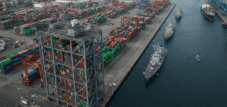
15 billion euros for dilapidated ports: Will the money come from the defense budget? Is security of supply at risk? – Creative image: Xpert.Digital
Germany's seaports: Billions in investments for the maritime future
Fit for the future: This is how Germany's ports are to be modernized with billions of euros.
German seaports are facing one of the greatest challenges in their history. Rapidly growing international trade, the ongoing energy transition, and the changing geopolitical landscape necessitate massive investments in port infrastructure. At the same time, innovative technologies such as dual-use logistics and high-bay container warehouses offer groundbreaking opportunities for the future-proof modernization of German ports.
The urgent investment needs of German seaports
The outdated infrastructure of German seaports has become a critical problem. The Central Association of German Seaport Operators (ZDS) has identified a massive backlog of necessary renovations that urgently needs to be addressed. The outdated quay walls, inadequate hinterland connections, and lack of heavy-lift areas significantly impair the competitiveness of German ports.
Specific problem areas include
- Dilapidated quay walls with structural damage
- Insufficient heavy-load areas for modern container handling facilities
- Deficient hinterland via road and rail
- Outdated digital infrastructure and communication systems
These structural deficiencies have already led to noticeable competitive disadvantages. German ports are struggling with higher costs, longer turnaround times, and lower productivity compared to European competitors like Rotterdam and Antwerp. While Dutch and Belgian ports benefit from government support for infrastructure financing, German terminal operators have to pay high rents and leases for quay walls.
Suitable for:
- Europe | Fragile global supply chains and no end: Ship traffic jams at Europe's ports of Rotterdam and Antwerp
The 15 billion euro demand: A strategic approach
The ZDS, under the leadership of Angela Titzrath, has developed a well-thought-out financing strategy. The requested 15 billion euros represent only three percent of the federal government's planned special infrastructure fund. This relatively small sum could enable all urgently needed modernizations within twelve years and make Germany a competitive port location once again.
The financing strategy envisages
- Diversified sources of financing: In addition to the special infrastructure fund, the defense budget, the climate fund of the Federal Ministry for Economic Affairs and Climate Action and funds from the transport ministry are also being considered.
- Increase in port burden compensation: An increase from the current 38 million euros to 400 to 500 million euros annually is intended to ensure sustainable basic financing.
- Additional federal funding: The 400 million euros already pledged from the Climate and Transformation Fund for the next four years are an important first step.
Dual-use logistics: Civilian and military synergies
The dual-use logistics concept represents an innovative approach to maximizing the efficiency of port infrastructure through its simultaneous use for civilian and military purposes. As a logistics hub for NATO, Germany bears a special responsibility for military mobility in Europe.
Key elements of the dual-use concept
- Multimodal integration: Optimal interlinking of road, rail and sea transport for both modes of use.
- Flexible infrastructure: Port infrastructures that can support both civilian trade flows and military logistics
- Synergistic cost sharing: Joint financing and use reduces costs for both areas.
- Strategic resilience: Increased resilience and security of supply chains
German seaports already play a central role in NATO logistics. Projects like the NATO Deployment Hub at the Warnow shipyard in Rostock demonstrate how military and civilian port use can be successfully combined. The German Armed Forces utilize German ports like Emden for strategic maritime transport, as military logistics services are already available there.
Suitable for:
Container high-bay warehouses: The revolution in port logistics
One of the most promising innovations for the modernization of German container terminals is high-bay container storage (HBS). This technology enables a drastic increase in storage capacity while simultaneously optimizing operational efficiency.
Technical advantages of container high-bay warehouses
- Triple the storage capacity: Up to three times as many containers can be stored on the same footprint as in conventional yards.
- Elimination of re-stacking: Direct access to every container without time-consuming re-stacking.
- Full automation: Robot-controlled high-bay warehouse operators work around the clock without human intervention.
- Weather independence: Enclosed storage systems enable continuous operation under all weather conditions.
Operational improvements through HRL
- 20% higher handling capacity at the quay through optimized container provision
- 20% shorter processing times for trucks thanks to precise planning
- Reduction of CO₂ emissions through electric drive and optimized logistics
Suitable for:
- The top ten of the container high-class bearing manufacturers and guidelines: technology, manufacturer and future of port logistics
The strategic importance for the energy transition
German seaports play a key role in the transition to a sustainable energy economy. They are central hubs for the import of liquefied natural gas (LNG), green hydrogen, and other renewable energy carriers. At the same time, they serve as base ports for the expansion of offshore wind energy.
Port functions relevant to the energy transition
- LNG terminals: Import of liquefied natural gas for energy supply (already in operation in Wilhelmshaven, Brunsbüttel and Stade)
- Hydrogen import: Construction of import terminals for green hydrogen and ammonia
- Offshore wind logistics: assembly, transport and maintenance of offshore wind turbines
The Offshore Wind Energy Foundation estimates that up to 200 hectares of additional heavy-load-bearing land will be needed by 2029 for the construction of new offshore wind farms alone. This illustrates the enormous land requirement that modern high-bay warehouses can efficiently manage thanks to their vertical design.
Hub for security and defense - advice and information
The hub for security and defense offers well-founded advice and current information in order to effectively support companies and organizations in strengthening their role in European security and defense policy. In close connection to the SME Connect working group, he promotes small and medium -sized companies (SMEs) in particular that want to further expand their innovative strength and competitiveness in the field of defense. As a central point of contact, the hub creates a decisive bridge between SME and European defense strategy.
Suitable for:
Competitiveness made in Germany: Military and economy united – The new strategy for German ports?
Hamburg as a pioneer in port digitization
The Port of Hamburg, under the leadership of HHLA, is playing a pioneering role in the digitalization of the German port landscape. During her nine-year tenure as CEO of HHLA, Angela Titzrath invested over €500 million in the modernization of Hamburg's terminals.
Digitalization initiatives in Hamburg
- 5G campus network: Installation of a €2.3 million 5G test field at the Altenwerder container terminal
- Complete truck digitization: Over 200,000 truck accesses were already processed digitally via the Passify app in 2024.
- Automated container cranes: Remotely controlled container cranes at the Altenwerder terminal
- HHLA Next: Innovation and Venture Building Unit for Digital Solutions
Hamburg's successful digitalization demonstrates how German ports can strengthen their competitive position through technological innovation. However, these local successes alone cannot solve the structural financing problems.
Suitable for:
European competition and strategic challenges
German seaports face intense competition from their European counterparts, particularly Rotterdam and Antwerp. These ports benefit from government support and more favorable conditions. Rotterdam, for example, treats quay walls as flood protection structures, fully funded by the state, while German terminal operators have to pay high rents.
Competitive disadvantages of German ports
- Higher port costs: Terminal operators have to rent quay walls instead of using them free of charge.
- Bureaucratic hurdles: More complex approval processes and longer processing times
- Tax disadvantage: Import VAT and other tax burdens
- Limited 24/7 availability: Restrictions on hinterland connections on weekends
Despite these challenges, German ports have the opportunity to become technological leaders and set new standards through innovative solutions such as high-bay container warehouses.
Suitable for:
The military dimension: Germany as a NATO hub
The changed security situation in Europe has significantly increased the importance of German seaports for military logistics. Germany acts as a central hub for troop movements and material transfers to NATO's eastern flank.
Military port use includes
- Host Nation Support: Support for foreign armed forces during transport through Germany
- Strategic sea transport: Deployment of heavy equipment to exercises and operations
- NATO Deployment Hubs: Specialized logistics centers for alliance operations
- Dual-use infrastructure: Shared use of civilian and military logistics chains
This military dimension justifies partial financing from the defense budget and underlines the national security relevance of the port infrastructure.
Suitable for:
Financing models and political solutions
Financing the port modernization requires a systematic approach that combines various funding sources. The current port burden compensation of €38 million annually is completely inadequate for the enormous challenges.
Innovative financing approaches
- Special fund for infrastructure: 15 billion euros as a strategic investment in future viability
- Cross-departmental financing: combination of transport, defense, climate and economic funds
- Project-based funding: Targeted support for particularly significant investments
- Long-term basic financing: Increase of the annual port burden compensation to 500 million euros
The CDU/CSU parliamentary group has already submitted concrete proposals for improved port financing and is calling for the establishment of a federal funding program for quay and waterfront facilities. These political initiatives demonstrate that the problem has been recognized and solutions are being developed.
Recommendations for action
The German port industry is at a turning point. The decisions made in the coming years will determine whether Germany maintains its position as a leading port location in Europe or loses it to competitors like Rotterdam and Antwerp.
Strategic recommendations for action
- Immediate provision of the 15 billion euros from the special infrastructure fund
- Implementation of container high-bay warehouses as flagship projects at strategic locations
- Establishment of a dual-use logistics network for civilian and military use
- Digitalization initiative based on the Hamburg model in all German ports
- European coordination to improve competitive conditions
The investment of 15 billion euros may seem high at first glance, but it is entirely appropriate given the economic importance of the ports and the long-term costs of not modernizing them. German seaports handle approximately two-thirds of Germany's foreign trade and are therefore systemically important for the entire economy.
A new beginning in the maritime future
German seaports have the potential to become world leaders through innovative technologies such as high-bay container storage and dual-use logistics concepts. The required 15 billion euros in investment is not a cost, but a strategic investment in the future that can establish Germany as a leading port location in the long term.
The combination of modern automation technology, sustainable energy infrastructure, and intelligent dual-use utilization offers unique synergies. Container high-bay warehouses can enable urgently needed capacity increases while simultaneously optimizing space, and the dual-use concept efficiently meets both civilian and military requirements.
The time to act is now. Every year of delay exacerbates competitive disadvantages and increases long-term costs. With the right financing strategy and the consistent use of innovative technologies, German seaports can regain their leading role in Europe and be prepared for the challenges of the 21st century.
Angela Titzrath's vision of a modern, competitive port infrastructure is not only feasible, but essential for Germany's economic future. The €15 billion investment would not only renovate dilapidated quays and create much-needed heavy-load cargo areas, but also strengthen Germany's position as a maritime nation for decades to come.
Advice - planning - implementation
I would be happy to serve as your personal advisor.
Head of Business Development
Chairman SME Connect Defense Working Group
Advice - planning - implementation
I would be happy to serve as your personal advisor.
contact me under Wolfenstein ∂ Xpert.digital
call me under +49 89 674 804 (Munich)

